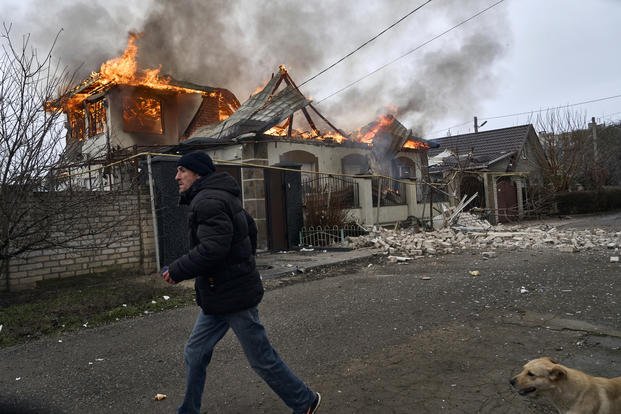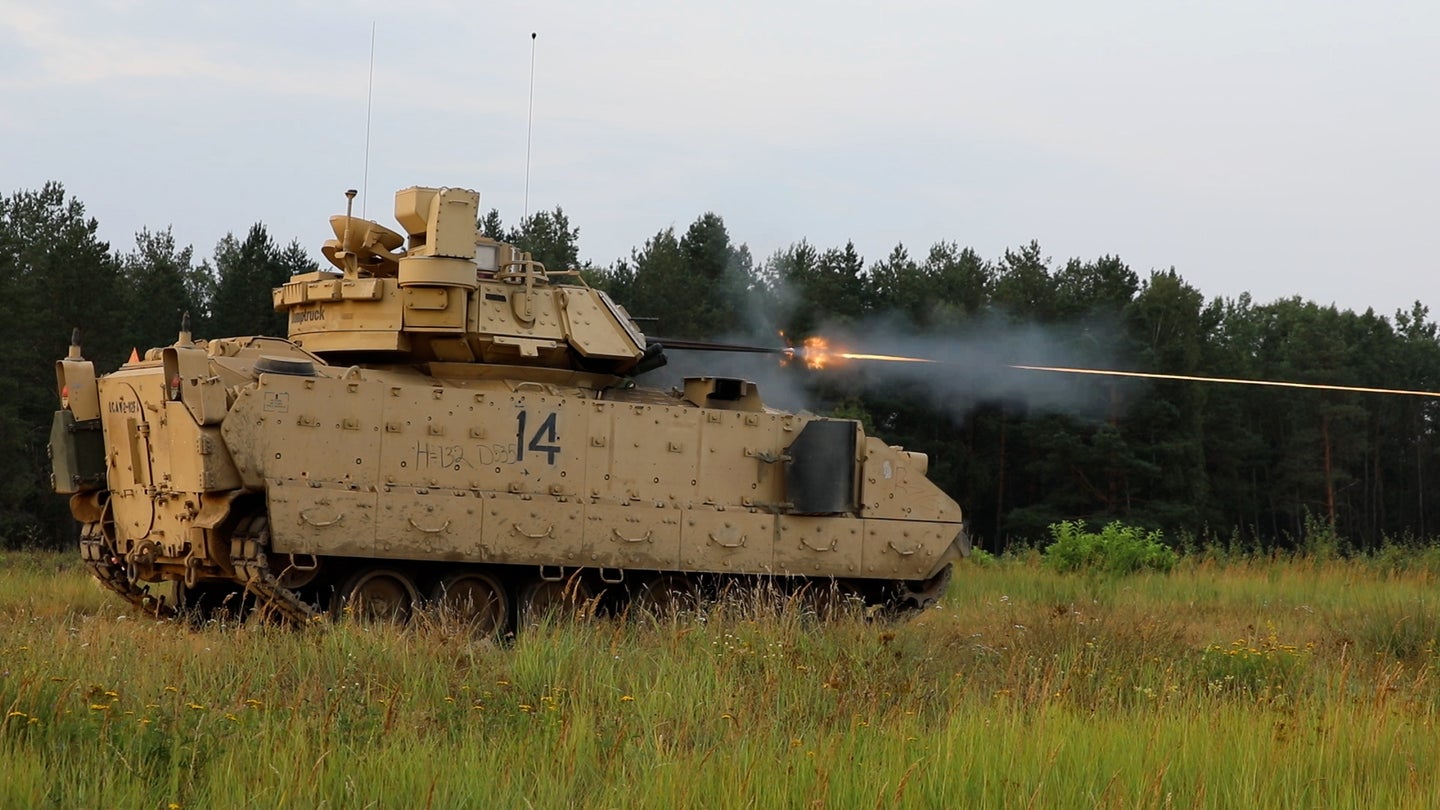
A local resident runs past a burning house hit by the Russian shelling in Kherson, Ukraine, on the Orthodox Christmas Eve Friday, Jan. 6, 2023. (AP Photo/LIBKOS)
The Pentagon is for the first time sending Bradley Fighting Vehicles to Ukraine, as well as nearly 300 other armored vehicles as part of a new aid package that will coincide with a new training program for Kyiv’s forces.
The Bradleys, as well as American-supplied Patriot surface-to-air missile systems; M113 Armored Personnel Carriers; Mine-Resistant Ambush Protected vehicles, known as MRAPs; and Humvees, are part of what defense officials said is the largest Ukraine security aid package yet, worth $2.85 billion.
Those weapons will be joined by ramped-up training for Ukrainian troops within the coming month, preparing them to take advantage of the new tools as the Russian invasion approaches its first anniversary next month.
Ukraine Soldiers Prepare for Possible Offensive From NorthAs fierce battles continue to take place in eastern Ukraine, Ukrainian troops are on high alert also in other border areas, including in the north. (Jan 5) APCurrent Time 0:19/Duration 2:49Loaded: 41.02%
“We will be able to enable the Ukrainians to take advantage of this capability, and again, not just actually to employ it on the battlefield but to maintain and sustain it,” Laura Cooper, the deputy assistant secretary of defense for Russia, Ukraine and Eurasia, said during a press conference at the Pentagon on Friday.

The new combined arms and joint maneuver training is slated to begin within a couple of weeks in Germany and will train roughly a battalion of Ukrainian troops — around 500 — each month, Brig. Gen. Pat Ryder, the Pentagon’s top spokesman, told Military.com during a briefing to the press on Thursday.
“That is going to provide them with advanced training … training that we had been providing before the invasion that we had to stop doing because of the invasion,” Ryder said.
The Pentagon said no additional troops are expected to be deployed to Europe for the training. Before the Russian invasion last year, the U.S. provided years of training and security aid to Kyiv, including placing American troops in Ukraine, escalating in 2015 in the hopes of fending off further aggression by Moscow. U.S. trainers evacuated the country ahead of last year’s Russian attack.
Cooper said the combined arms training will help the Ukrainians integrate all of their battlefield capabilities and better maneuver to push back the Russian positions in the east and the south of the country, where heavy fighting has concentrated since Russia abandoned its plans to capture the capital Kyiv.
“So that’s what we’re looking forward to seeing in the coming months,” Cooper said.
Training of Ukrainians on the Patriot batteries, one of the U.S. military’s most effective air defense systems, has yet to be worked out after a decision to send those last month, according to Ryder. On Thursday, the Pentagon was considering the possibility of training Ukrainians on the Patriot system within the U.S. or at some locations abroad, or both.
U.S. troops in Germany, as well as other ally nations, have been providing training on the various weapons systems, which have included Javelin missiles; newly unveiled Phoenix Ghost explosive drones; and the High Mobility Artillery Rocket System, or HIMARS.

The new U.S. training will also be provided for the Bradleys. France announced Wednesday it is sending AMX-10 RC armored fighting vehicles to Ukraine, and a day later Germany said it is contributing Marder infantry fighting vehicles.
The tally of U.S. weapons sent to Ukraine is growing long, equaling a total of $22 billion worth of hardware and equipment since Russian President Vladimir Putin ordered the invasion on Feb. 24, 2022.
The decision to give Bradleys to Ukraine comes as the war has turned into a brutal grind during the winter, and the Ukrainians have managed to keep the Russian forces on their heels by clawing back some territory and pulling off a missile strike on a Russian base this month that killed at least 63. Cooper said the Pentagon expects Russia to attempt to gain back territory, and the Bradleys could allow the Ukrainians to move more effectively around the battlefield when countering any offensive.
Bradleys are often used in conjunction with heavier armor, deploying in what are known as “hunter-killer” teams where the smaller, less-armored, but more mobile Bradleys reconnoiter targets then direct tanks to destroy them.
The U.S. package included 45 T-72B tanks, a Soviet main battle tank also used by the Russians, though officials did not specifically say they would be married to the accompanying Bradleys on the battlefield. The U.S. uses the M1A2 Abrams tank, a formidable piece of armor that is on the Ukrainians’ shopping list.
The Bradley is not a tank, despite a common misconception based on its tracks, armor and weapon system. Military.com spoke to four senior instructors at the Army’s Bradley functional courses, schools at Fort Benning, Georgia, that teach American officers and noncommissioned officers the art of Bradley fighting.
“You can see why there’s a misconception, because a picture only tells you so much, but the purpose behind it changes that,” 1st Sgt. Michael Waddell, the noncommissioned officer in charge of all the courses, said Friday.
That purpose, the instructors said, is to transport ground soldiers closer to the fight, provide them direct fire support once they get there, defend against tanks, and help rid the battlefield of entrenched infantry.
The vehicle is manned by a crew of three, which includes a driver, gunner and a commander. It can pack seven additional personnel — most often infantry or cavalry scouts — in the back, the instructors said.
“The Army needed a way to get its fighting soldiers closer to the battlefield,” Sgt. 1st Class Bradley Linder, a senior instructor, said. “And they needed to have the support of a vehicle-mounted weapons system.”
The platform boasts three different weapon systems, Sgt. 1st Class Daniel Goeppner, the Bradley Master Gunner senior instructor, said: a 7.62mm coaxial machine gun; a 25mm Bushmaster chain gun; and a tube-launched, optically tracked, wire-guided missile system, known as a TOW.
“So what that really allows is for you to be able to engage and defeat targets or enemy from individual personnel all the way up to tanks,” Goeppner said.
But, the instructors warned that, despite the vehicle’s mobility, versatility and capability, it — specifically referencing the TOW, which can destroy an enemy vehicle nearly two and a half miles away — has limitations.
“It is only used for us as a defensive weapon system because we must be stationary to engage with [the enemy],” Linder said, referencing the TOW’s need to have an operator lock onto a target until missile impact while the vehicle is not moving. “It would not be something that I would utilize or that should be utilized as a first resort.”
The war in Ukraine has proved to be an armor graveyard, where other U.S.-supplied anti-tank weapons have taken out hordes of Russian tanks.
It typically takes the Army about five weeks to train leaders how to operate, maintain and use the Bradleys — a time frame akin to what the Ukrainians are expected to have.
American basic trainees usually get some time on the platforms in their final weeks of initial entry training as well, and when battalions get new equipment, they typically take over two months to familiarize themselves with it, the instructors said.
The Pentagon said it’s sending 50 Bradleys to Ukraine, about one-third of what is typically in an American Armored Brigade Combat Team. The new aid package includes a quarter of a million rounds of 25mm ammunition for the Bushmaster and 500 TOW missiles.
Though the Bradley has been in the American arsenal for more than 40 years, if it sees direct combat against Russian troops, it could be the first for the platform in a conventional conflict since the first Gulf War.
— Travis Tritten can be reached at travis.tritten@military.com. Follow him on Twitter @Travis_Tritten.
— Drew F. Lawrence can be reached at drew.lawrence@military.com. Follow him on Twitter @df_lawrence.
Source: military.com








